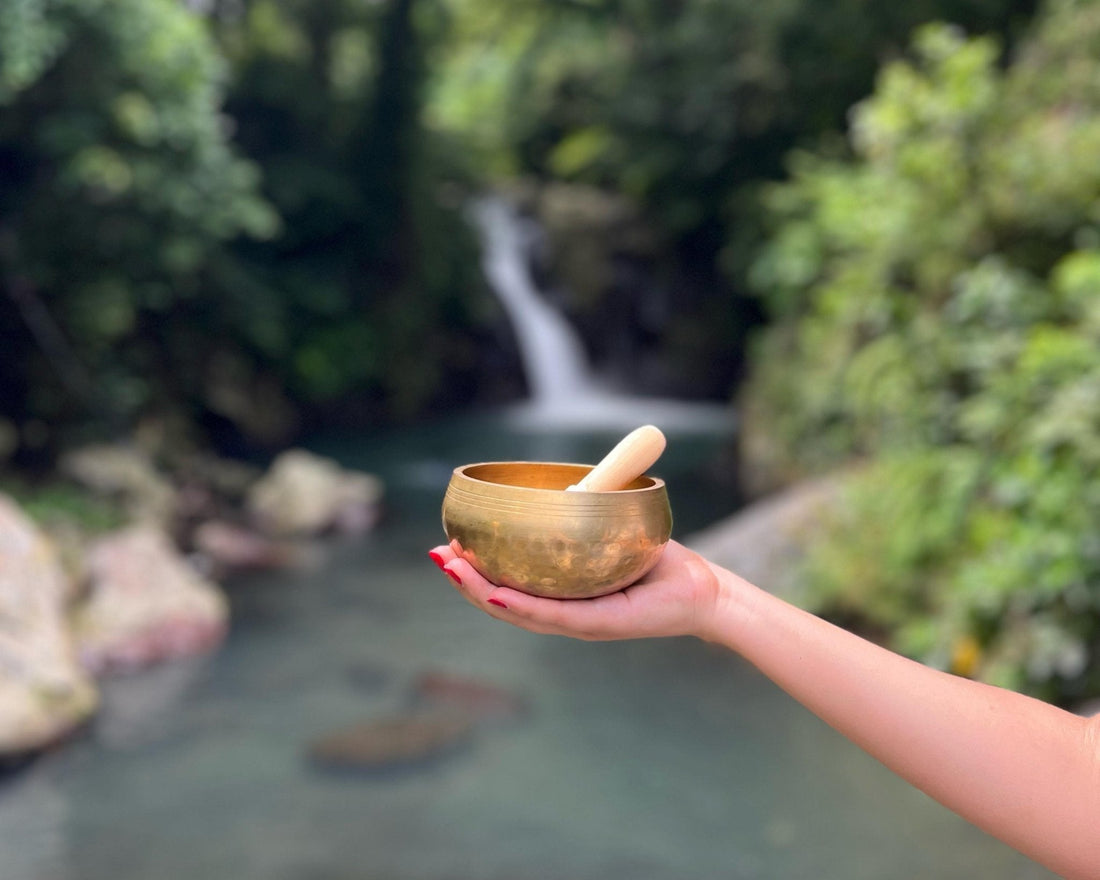
The 7 chakra notes of singing bowls explained
If you’re new to playing Tibetan singing bowls, you’ve probably run across some discussion about chakra notes. You may have even seen a chakra notes chart online or spotted references to 7 chakras and 7 notes.
But what are chakra notes? And how should they impact your singing bowl playing – if it all?
Well, to properly understand chakra notes, we need to have a look at chakras more broadly.
Chakras – their origins and significance
The modern understanding around chakras is that they’re a type of psychospiritual energy centre within the body. In most belief systems, they’re aligned with a specific part or area of the body, with the exact number of them usually between 5 and 7.
7 is the most commonly agreed-upon number today, which is where the idea of 7 chakras, 7 notes comes from – but more on that later.
Over the centuries, a number of different religions and schools of thought have claimed that maintenance of these chakras via meditation or religious practice is key to the well-being of the body and mind.
Some have also taught that it’s possible to harness the power generated by chakras and use them to generate near-superhuman stamina or supernatural effects. Probably the best known of these to Westerners is Tantra, thanks to its association with sex and eroticism.
However, chakras are found in a number of different religions across the Indian subcontinent. Their exact origins are a bit uncertain; the word “chakra” itself simply translates to “wheel” and so it’s used in a variety of literal and metaphorical senses in ancient Vedic texts.
These ideas seem to have been fairly esoteric for long periods of history, rather than mainline practice among everyday Hindus, Buddhists or Jainists.
The earliest references that we’d probably understand in the modern sense seem to date to around the 1st millennium CE. Some centuries later, Sir John Woodroffe's 1919 book The Serpent Power would subsequently be quite influential in introducing the idea of seven chakras to a Western audience.
Other themes would be introduced by others over the following decades, such as chakra colours and chakra notes.
The modern, New Age-inspired understanding of chakras would eventually coalesce around the late 70s. This understanding draws on esoteric traditions from Buddhism, Hinduism and Jainism. However, it’s also been supplemented by a range of other esotericists, writers and schools of thought.
As with many New Age ideas, you don’t need to look very far to see the influence of Theosophy, Carl Jung and Rudolf Steiner, to name a few. Other scholars have also drawn parallels between chakras and other religious or mystical traditions, such as qi flowing down meridian lines, or the Tree of Life in Kabbalah.
Chakra notes
Chakra notes are a relatively recent concept – but they’ve gathered a significant amount of traction within the last couple of decades.
Today, many people who utilise sound healing believe that different musical notes correspond with different chakras within the body. Usually this is geared around the idea of 7 chakras and 7 notes, to correspond with a modern Western musical scale.
Playing the appropriate notes on a chakra singing bowl – usually accompanied by some form of meditation or other ritual practice – can help unblock chakras and potentially help address health or wellbeing concerns in the process, too.
It’s important to note that this isn’t a unified belief across all sound healers, by any means. Some believe that the sound itself is enough and that the emphasis on chakras isn’t necessary to obtain healing.
For others, there’s considerable overlap with ideas about vibrational healing, and you can find any manner of elaborate discussions online about which is the best frequency to use when playing singing bowls.
There’s also some contention among sound healing practitioners around whether it is even appropriate to apply modern musical scales to chakras.
But for those who simply want to buy a singing bowl, the conversation can get pretty overwhelming pretty quickly. So suffice to say you can often find sellers offering singing bowls which are supposed to correspond to a specific chakra.
You can find all sorts of chakra notes charts on Google Images, but we’ll give you a breakdown here. We’ve also included the colour coding for easy reference, too.
Located at the base of the spine, the root chakra is associated with the C note and the colour red. It’s considered to play a role in survival, and provide grounding in the physical realm.
Sitting between the navel and pubic bone, the sacral chakra is associated with the colour orange and D note. It plays a role in governing relationships, sexual energy and creativity.
Located in the solar plexus – halfway between the breastbone and the navel – the solar plexus chakra has yellow as its colour. It’s considered to be associated with willpower, and resonates with the E note.
Located in the centre of the chest, the heart chakra is (perhaps unsurprisingly) associated with love. Its colour is green, and its musical tone is the F note.
Sitting at the base of the throat, this chakra is believed to play a role in creativity and communication. Its colour is blue (sometimes azure blue specifically) and it resonates with the G note.
Sitting in the centre of your forehead, your Third Eye Chakra is believed to resonate with the A note and the colour indigo. This chakra oversees intuition and understanding.
The Crown Chakra sits atop the head and is associated with the B note, the colour violet and a range of considerations such as spiritual connections, understanding and kundalini energy.
| Chakra | Associated Musical Note | Mantra |
|---|---|---|
| Root (Muladhara) | C | Lam |
| Sacral (Svadhisthana) | D | Vam |
| Solar Plexus (Manipura) | E | Ram |
| Heart (Anahata) | F | Yam |
| Throat (Vishuddha) | G | Ham |
| Third Eye (Ajna) | A | Om or Aum |
| Crown (Sahasrara) | B | Sahasrara (No specific mantra) |
Chakra notes and playing your singing bowl
So, how does all of this affect how you should play your singing bowl?
Well, it’s more or less up to you. Some people who use singing bowls make chakra notes a prime consideration; others will never even hear about them and still thoroughly enjoy their singing bowls for years.
But as we’ve mentioned in previous articles, it’s always worth treating these health claims with a degree of scepticism. Building up artificial mystique is very common in alternative medical circles and healing based around chakra notes is no exception.
However, looking after your mental health is an important part of looking after your wellbeing, and some people do find singing bowls helpful for this process.
We’d always suggest that you speak to a medical professional if you’re unwell, and that singing bowls be used as a type of complementary therapy as opposed to a primary form of care.
Learn more about singing bowls with Mindful Store
Here at Mindful Store, we’re a meditation shop that sells a wide range of aids and accessories, including Tibetan singing bowls.
We also offer a range of resources through our blog; you can discover how to play singing bowls, the uses of singing bowl mallets and much more!
To find out more, just get in touch with the team at Mindful Store today.
